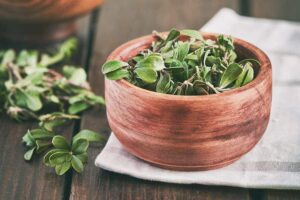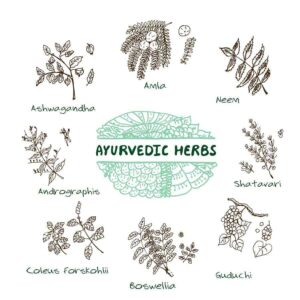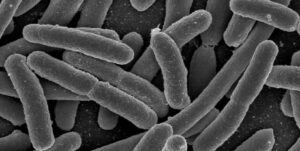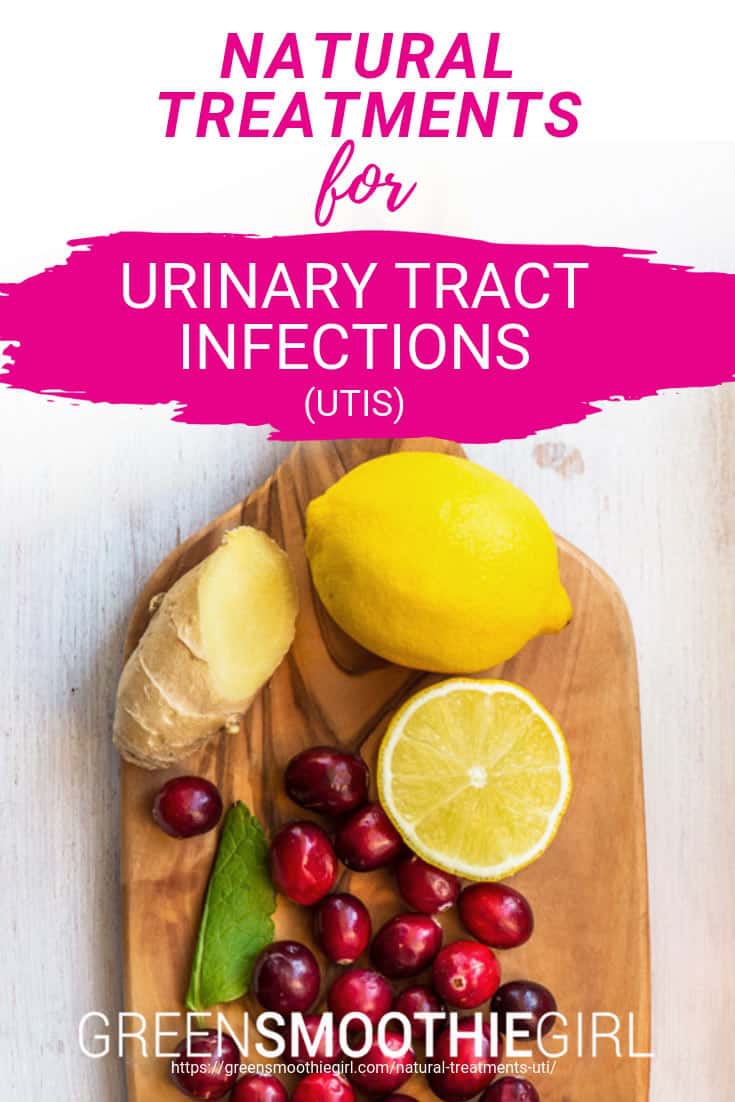Natural Treatments for Urinary Tract Infections (UTIs)

Urinary tract infections (UTIs) are some of the most common bacterial infections, particularly among women. It is estimated that at least 50 percent of females will develop a UTI in their lifetime and 1 in 4 women will have recurring or chronic urinary tract infections. 1,2
For most, the prescribed traditional treatment is antibiotics. These, unfortunately, lead to multi-drug resistant microorganisms and long-term changes in the microbiota of the vagina and gastrointestinal tract. In fact, over 20 percent of women taking antibiotics for this type of infection will develop a different type of infection, Candida albacans, which is the overgrowth of a fungus that normally resides in our bodies.3
This infection can become systemic and lead to a host of health issues including leaky gut syndrome which allows undigested food particles, toxins, viruses and bacteria to pass through the intestinal wall and into the bloodstream. If left unchecked, your immune system goes to work fighting off these foreign invaders and, in time, an autoimmune disorder may be the result.
Other possible side effects of antibiotics include nausea, diarrhea, vomiting, rash, headaches, and fatigue.
Fortunately, there are several natural treatments for UTIs, treatments that leave you healthy and without the many side effects that can occur with the mainstream treatment of antibiotics.
In this post:
- What is a UTI?
- Antibiotics as the Mainstream Treatment of Choice
- The Alternative: Natural Treatments for Urinary Tract Infections
- Can UTIs Become Dangerous
- Food as Medicine for Urinary Tract Infections
- Prevention is the Best Medicine for UTIs
- The Bottom Line
What is a UTI?
UTIs are bacterial infections that occur in any part of the urinary tract, including the urethra, bladder, ureters, and kidneys. The bladder and urethra are the most common areas affected. In women, they are often the result of bacteria found in the large intestine that make their way into the urethra and bladder. In men, they are often caused by restricted urine flow, such as that which occurs with an enlarged prostate.
While our immune system often comes to the rescue and eradicates the bacteria (in fact, 25 to 42 percent of UTIs resolve on their own), in some cases, small clusters of bacteria may persist which may ultimately lead to recurrent UTIs.4
What are the Symptoms of a UTI?
The most common symptoms 5 that women report are:
- Pain or a burning sensation upon urination
- Feeling a frequent and urgent need to urinate, but passing little to no urine
- Urine has a strong smell and is milky, cloudy, or reddish in color
- Feeling tired and/or having a fever
- Pain in the lower back or pressure in the lower abdomen
- In older adults: confusion, agitation, fatigue, and loss of appetite
Some women are asymptomatic and have no idea that they have a UTI until a lab test reveals the infection. This type of infection is known as a “silent UTI,” and if left untreated, it can spread to the kidneys and bloodstream. The symptoms associated with this type of urinary tract infection include fatigue, nausea, loss of appetite, and confusion.

UTIs can be very painful, and in some cases, require visits to the hospital.
Up to 80% of women will get at least one UTI in their lifetime, with 20-30% of these women suffering from recurrent bouts. 6
Who is Susceptible to a UTI?
Women are more susceptible to UTIs as they become sexually active and when they age.1 Symptoms may occur shortly after intercourse and, for some, are associated with the use of spermicides and/or diaphragms.
For those who are post-menopausal, a decrease in estrogen is associated with an increase in UTIs. This occurs because estrogen stimulates an increase in beneficial bacteria such as lactobacilli in the vaginal microbiota flora which decreases the colonization of bad bacteria such as E. coli and reduces the pH levels.
Those with diabetes are also more prone to these infections because of a compromised immune system and poor circulation which reduces the ability of white blood cells to fight off the infection.
UTIs may also be caused by the undergarments we choose. Underwear that is tight-fitting and made of synthetic material such as polyester or nylon creates the perfect moist and warm environment for bacteria to breed in. Cotton is your best bet.
Bath bombs and oils, as well as deodorant sprays and lotions that contain chemicals and dyes, can also increase your chances of developing a UTI. And, of course, failing to wipe from front to back.
Antibiotics as the Mainstream Treatment of Choice
Typically, many UTI sufferers feel symptoms coming on and run to the doctor for a prescription of antibiotics. In fact, over 8 million people a year do just that.
[Related article: Before You Give Your Child Antibiotics, Antacids, or ADD Meds: What A Holistic Pediatrician Wants You To Know]
While this form of treatment may kill the bacteria (typically E. coli) that has caused the infection, it comes along with a host of side effects that can cause long-term diseases—much worse than the imbalance they were trying to cure in the first place!
These side effects range from headaches or nerve damage to altering the gut’s microbes, which then leads to systemic Candida infections and leaky gut, a syndrome that may ultimately result in an autoimmune disorder.
Studies show that children treated with antibiotics are also at a greater risk for developing several diseases, like diabetes, asthma, allergies, and other autoimmune disorders as they age. In 2010, the 74.5 million prescriptions for children averaged to one prescription of antibiotics for every child in the U.S.! 7
According to a report in BMC Medicine, broad-spectrum antibiotic prescriptions doubled from 2000 to 2010. Even worse? Studies have shown that 50% of outpatient antibiotics prescribed are unnecessary.8
And the more we use antibiotics, the more the ever-present bacteria adjust to the onslaught and either alter their makeup in order to become impenetrable or take the offense and attack and kill the antibiotic before it kills them.
An example of this adjustment is MRSA, or methicillin-resistant Staphylococcus aureus, a bacterium now known as a “super bug” due to its resistance to antibiotics. It causes mild infections on the skin to serious infections in wounds, lungs, and the urinary tract.

Many kinds of bacteria have become resistant to antibiotics.
The World Health Organization (WHO) considers the emergence of antimicrobial resistant bacteria one of the three greatest threats to human health.7
[Related article: What To Do When You’ve Taken Antibiotics]
The Alternative: Natural Treatments for Urinary Tract Infections
Fortunately, there are natural treatments that have been shown to successfully treat UTIs, with studies to back their use. Each of them are good preventatives, as well.
Probiotics
Maintaining a healthy vaginal and intestinal microbiota flora is one of the best remedies as well as preventative strategies. As in most stories, good triumphs over evil, and so is the case with good bacteria overcoming bad bacteria. Several studies show that probiotics can recolonize the vagina and bladder with healthy microbiota, preventing UTIs from occurring in the first place.9
This good bacteria is responsible for helping us digest our food, creates neurotransmitters and vitamins, supports our immune system, and repels pathogens. Probiotics, meaning “for life,” contain live strains of good bacteria that helps us maintain balanced intestinal microflora. Antibiotics do not differentiate between good and bad bacteria and destroy both the harmful bacteria and the normal, beneficial bacterial flora.
Adding a dose of our PreZyme Pro to your daily green smoothie will give your body the beneficial organisms it needs so that good will prevail. This plant-based GI tract supplement contains 15 strains of probiotics as well as a prebiotic, which probiotics feed on.
I believe the best way to establish your body’s healthy intestinal flora is to include fermented foods in your diet. These types of foods include kefir, Rejuvelac, sauerkraut, beet kvass, and kimchi. I am such a proponent of these foods that I place their importance and impact on our health right up there with drinking your daily green smoothies!
Cranberry Juice and Tablets
You've probably heard of this very popular remedy for UTIs. For many, drinking a good dose of cranberry juice at the first signs of an infection can reduce symptoms and bring the body back into balance in a short period of time.10
This is due in part to the tannin, or proanthocyanidin, that is found within cranberries and has the ability to reduce the colonization of E. coli.
Cranberries also contain polyphenols, antioxidants which have antibacterial and anti-inflammatory properties. Cranberry works by inhibiting the bacteria from adhering to the walls of the urinary tract, reducing the bacteria’s ability to grow and multiply.
Be sure to choose cranberry juice that has no added sugar or high fructose corn syrup.
You can also make your own cranberry juice by bringing 12 oz of fresh cranberries and 1 cup of water to a boil, then simmering for 15 minutes. Allow the concoction to cool down a bit and then add to a blender with 5 cups of water. For those that need a little sweetness, a touch of local, organic honey or raw, organic agave will do the trick.
One great way to include this and other healthy fruits and vegetables into your diet is with our Tart Berry Blast smoothie which includes cranberry juice, kale, and mixed berries as well as pomegranate seeds—a fruit high in conjugated linolenic acid which helps burn fat.
Vitamin C
Linus Pauling, a biochemist and educator, first touted the benefits of vitamin C in the 1960s, claiming it to be a cure for heart disease, cancer, and infections. Vitamin C is now well-known for its immune-boosting properties. This alone makes it a worthy addition to the fight against urinary tract infections. In addition, an instructor at Harvard Medical School reported that taking vitamin C may help prevent bacteria from growing due to its ability to acidify urine.11

Whole-food sources of vitamin C are best.
While clinical trials have had mixed results, a meta-analysis revealed 148 animal studies that indicated that vitamin C “may alleviate or prevent infections caused by bacteria, viruses, and protozoa.”12
Keep in mind that ascorbic acid is not vitamin C, but rather an isolated component that is, unfortunately, often created in a lab. This synthetic version can be dangerous. For this reason, look for vitamin C that is derived from organic food sources and one that has no additives. Foods rich in vitamin C include blackberries, strawberries, leafy greens, papayas, peppers, kiwis, and citrus fruits.
Adding the Mustard Greens Mambo smoothie to your diet offers an elixir of four of these elements, making it a potent Vitamin C concoction.
[Related article: 7 Natural Immune-Boosters and Viral Killers]
D-Mannose
This naturally-occurring sugar that is found in many fruits such as oranges, apples, blueberries, and peaches is considered one of the most effective natural treatments for UTIs. It works by attaching itself to E. coli, the most common bacteria associated with UTIs, thereby causing the E. coli to stick to each other instead of the walls of the urinary tract. The bacteria are then eliminated when you urinate. It is the active ingredient in cranberry juice.
A study reported in the World Journal of Urology revealed that D-mannose was as effective as nitrofurantoin, an antibiotic, in preventing UTIs.13
One way to obtain more of this simple sugar is by eating the whole foods in which it is found. One of my favorite smoothies of the season, Summer Surprise Smoothie, contains blueberries as well as maca root powder. Maca root, considered sacred in Incan culture, has been used to balance hormones, increase vitality, and as an aphrodisiac. It also improves prostate function and relieves bladder pain.
Keep in mind that while 90 percent of UTIs are caused by E. coli, for the 10 percent that are not, D-mannose will not be effective.
While I advocate eating (and drinking) whole foods to support health instead of supplements derived from food, helping your body direct an attack on invading bacteria by taking a potent supplement to rid yourself of the invader is an important step in creating a healthy body. But remember that a whole foods diet will promote your health on a long-term, daily basis.
Apple Cider Vinegar
If you spend time on Pinterest, you know that organic apple cider vinegar is in the spotlight. From weight loss to lowering blood sugar and cholesterol levels, its health benefits are many.
It’s also been shown to kill pathogens, including bacteria such as E. coli.14
One of my favorite methods for incorporating this health-giving staple is in our immune-boosting hot drink that also includes garlic (antibacterial, antifungal, and antiviral), ginger (anti-inflammatory), and cayenne pepper (anti-irritant and circulatory stimulant). Combining these three herbs with apple cider vinegar is a great addition to your diet, not only when you’re starting to feel a cold or flu coming on, but as a regular immune booster.
Keep in mind: Apple cider vinegar should be organic and unfiltered. A quality brand available in most stores is Bragg’s.
Plant-Derived Anti-Biofilm Products
When bacteria colonize, they create a protective layer called a biofilm.15 Here, they encase themselves in a protective coat of protein fibers known as amyloid, the same protein that snarls neurons in the brains of those who have Alzheimer’s.
This biofilm makes UTIs particularly difficult to treat and is one of the main reasons behind their chronic nature. The question then becomes: How does one disrupt these biofilms?
Several plants have been found to possess the ability to target biofilms.16 These include garlic, cranberry, ginkgo biloba, phloretin (an antioxidant found in apples), limonoids (phytochemicals found in citrus fruits), and quercetin (a plant pigment found in apples, grapes, and berries—to name just a few of its sources).
If you're looking for a smoothie that incorporates several of these components, try our Cranapple Yogurt Crave.
Uva-Ursi (Bearberry Leaf)
This herb has been used medicinally since the 2nd century and is probably one of the most well-known herbs for treating UTIs. Native Americans used uva-ursi to treat bladder infections and as a tonic for strengthening the kidneys as well as a treatment for headaches.
When women with recurring bladder infections were given uva-ursi or a placebo, those who took the herb showed a statistically significant difference in the number of recurrences from those that took the placebo.17
This herb is not intended for long-term use and should not be used for more than 5 days in a row. Hydroquinone, one of its active ingredients, is a powerful antibacterial; however, if overused, it can cause liver damage. If you are pregnant or nursing, have high blood pressure, kidney or liver disease, do not take this herb.

Uva-Ursi (or Bearberry Leaf) was used by the Native American Nations to treat bladder infections.
Garlic
This superfood has been used for centuries and is one of the first plants documented for its healing attributes. It has been found in Egyptian pyramids and Greek temples and ancient medical texts from India, China, and Rome. From increasing stamina to warding off vampires, it is an herb with a rich history.18 The father of western medicine, Hippocrates, used it to treat cancer, pneumonia, and other infections. It has been shown to kill antibiotic-resistant bacteria such as MRSA.19 Today, we know it has astounding properties that make it antiviral, antifungal, antiparasitic, and antibacterial.20
Studies show that due to its antibacterial properties that block the growth of bacteria, garlic is a strong contender as a natural remedy for urinary tract infections.21
Our Winter Wellness Smoothie/Soup contains not only garlic, but a healthy dose of ginger, apple cider vinegar, and cayenne.
[Related recipe:Mum’s Magic Antiviral Hot LemonAid Tonic]
Coleus Forskohlii
This plant, indigenous to India, has been used in Ayurvedic medicine for 3,000 years. Today, it is widely used in body-building circles because of its ability to break down fatty tissue and stimulate metabolism.
Researchers at Duke University found that an extract from the plant known as forskalin has the ability to flush out colonies of bacteria that hide in the pouchlike structures of the bladder.22 Once flushed out, antibacterial agents would be needed to finish them off.

Coleus Forskohlii is an ayurvedic herb, one of the world's oldest holistic (“whole-body”) healing systems
Acupuncture
In addition to turning to the plant kingdom for support, there are natural therapies that have been shown to be highly effective in the treatment of UTIs.
Acupuncture is a healing tradition that originated in China thousands of years ago. Today, studies show that this type of treatment can reduce the rate of UTI occurrence among women prone to bladder infections by up to 50 percent.23
Oregano Oil
Oregano is a hardy perennial herb and a member of the mint family. The oil is derived from its leaves and flowers and has antibacterial, antiviral, and antifungal properties and is loaded with antioxidants. It is commonly put in capsules and used to treat nail fungus, thrush, sinus infections, yeast infections and, yes, you guessed it, UTIs.
A study aimed at investigating the antibacterial properties of oregano essential oil against E. coli found that it was effective in treating these bacterial infections.24
Taking this oil internally is not recommended for pregnant or nursing women, children, or those who are allergic to plants in the Lamiaceae family which includes mint, lavender, sage and basil.
The Future

Phosphoethanolamine cellulose (pEtN) is thought to protect bacteria from stressors, like antibiotics.
Can UTIs Become Dangerous
Yes. If left unchecked, UTIs can spread to the kidneys which can result in permanent kidney damage. This type of infection, though rare, can also lead to sepsis, a condition in which bacteria and toxins released by infectious organisms have entered the bloodstream and can spread throughout the body. As the immune system goes into overdrive, it releases large doses of chemicals into the body, triggering wide-spread inflammation and possible organ damage.
Food as Medicine for Urinary Tract Infections
Of course, I’m all about whole foods and a proponent of the philosophy that food really is our best medicine when it comes to UTIs or other ailments. And science backs me up.
A team of researchers from the Washington University School of Medicine found a protein called siderocalin in the urine of people with UTIs. Siderocalin can help stop the E.coli bacterial growth that typically causes UTIs, but only if the urine it’s in has a pH higher than normal (which means it is less acidic, and closer to neutral or the pH of water).26
The nutrients that they found the most effective in raising pH toward more alkaline levels were polyphenols, and the best way to get these antioxidants into your diet is by increasing your consumption of fruits and vegetables. Blueberries, elderberries, strawberries, raspberries and flaxseed are particularly rich in polyphenols.
Foods to avoid include refined carbohydrates and sugar, which acidify your urine and don’t activate the body’s defensive siderocalin proteins.
Prevention is the Best Medicine for UTIs
As Benjamin Franklin said, “An ounce of prevention is worth a pound of cure.” There are a few habits you can begin implementing in your life that will help prevent urinary tract infections. These habits include the following:
- Drink water! Preferably alkaline water. Not only will you keep your body hydrated, you will flush out toxins, including bacteria. Keeping your body alkaline and increasing urine pH increases the activity of siderocalin which inhibits bacterial growth. Drink at least 2 liters per day and add a touch of fresh lemon juice which also alkalizes your urine
- Eat a diet that promotes an alkaline internal environment. This means a whole foods diet rich in fruits and vegetables. And don’t forget your fermented foods!
- Be sure to urinate after sex. This precaution helps flush out any bacteria that may have entered your urinary tract.
- Avoid using spermicides which can increase irritation and have been linked to bacterial growth. One study found a high correlation between UTIs and the use of a diaphragm with spermicide.27
- If you do take a dose of antibiotics, be sure to reseed your gut with healthy bacteria by taking a high-quality probiotic and eating fermented foods.
- E. coli likes moist, warm environments. This means that those who are prone to UTIs will benefit from wearing loose cotton clothing. Cotton, as compared to nylon, is a natural fabric that allows for airflow.
- Avoid feminine products that contain chemicals and synthetic ingredients, such as those found in powders, sprays and douches. Natural is always better.
[Related: Toxic Cosmetic Ingredients To Avoid]
The Bottom Line
Urinary tract infections are yet another example of what occurs when our bodies are out of balance, whether due to physical, emotional, or mental stress.
So, what does one do to bring the body back into balance? Create a life that includes a rich plant-based diet, exercise that brings you joy, and activities that calm the mind and bring inner peace. According to Chinese medicine, our emotions are intricately linked to physical imbalances. An imbalance in the bladder is associated with fear, indecision, and long-standing grudges. Replace fear with trust and indecision with inner knowing.
Additional support for a healthy bladder includes lots of clean water and the avoidance of sugar, sodas, caffeine, alcohol, and processed table salt.
Read next: Oral Surgery With Natural Antibiotics (Narcotic- And Steroid-Free)

Disclosure: This post may contain affiliate links that help support the GSG mission without costing you extra. I recommend only companies and products that I use myself.
Sources
- Al-Badr, Ahmed et al. Recurrent Urinary Tract Infections Management in Women. Sultan Qaboos University Medical Journal. 08/2013. https://www.ncbi.nlm.nih.gov/pmc/articles/PMC3749018/
- Bladder Infection (Urinary Tract Infection—UTI) in Adults. National Institute of Diabetes and Digestive and Kidney Diseases. https://www.niddk.nih.gov/health-information/urologic-diseases/bladder-infection-uti-in-adults#i
- Foxman, Betsy et al. Alternative Approaches to Conventional Treatment of Acute Uncomplicated Urinary Tract Infection in Women. Current Infectious Disease Reports. 04/2014. https://www.ncbi.nlm.nih.gov/pmc/articles/PMC3622145/
- Bergamin, Paul A. et al. Non-surgical management of recurrent urinary tract infections in women. Translational Andrology and Urology. 07/2017. https://www.ncbi.nlm.nih.gov/pmc/articles/PMC5522788/
- Urinary Tract Infection (UTI). U.S. Department of Health & Human Services. https://www.hhs.gov/opa/reproductive-health/fact-sheets/urinary-tract-infections/index.html
- Urinary Tract Infections Send Millions of People to the Doctor Each Year. The Washington Post. 11/2013. https://www.washingtonpost.com/national/health-science/urinary-tract-infections-send-millions-of-people-to-the-doctor-each-year/2013/11/11/185c4748-c944-11e2-9245-773c0123c027_story.html?gsg_term=.74c8b43160b4
- Vangay, Pajau. Antibiotics, Pediatric Dysbiosis, and Disease. Cell Host & Microbe. 05/2015. https://www.cell.com/cell-host-microbe/fulltext/S1931-3128(15)00164-X?_returnURL=http%3A%2F%2Flinkinghub.elsevier.com%2Fretrieve%2Fpii%2FS193131281500164X%3Fshowall%3Dtrue
- Lee, Grace et al. Outpatient antibiotic prescribing in the United States: 2000 to 2010. BMC Medicine. 06/2014. https://bmcmedicine.biomedcentral.com/articles/10.1186/1741-7015-12-96
- Reid, G. et al. Probiotics to prevent urinary tract infections: the rational and evidence. 02/2006. https://www.ncbi.nlm.nih.gov/pubmed/16389539/
- Schmidt, DR et al. An examination of the anti-adherence activity of cranberry juice on urinary and nonurinary bacterial isolates. 1998. https://www.ncbi.nlm.nih.gov/pubmed/3063927/
- Stay a step ahead of urinary tract infections. Harvard Health Publishing Harvard Medical School. 02/2015. https://www.health.harvard.edu/diseases-and-conditions/stay-a-step-ahead-of-urinary-tract-infections
- Harri, Hemila. Vitamin C and Infections. Nutrients. 04/2017. https://www.ncbi.nlm.nih.gov/pmc/articles/PMC5409678/
- Kranjcec, B et al. D-mannose powder for prophylaxis of recurrent urinary tract infections in women: a randomized clinical trial. World Journal of Urology. 02/2014. https://www.ncbi.nlm.nih.gov/pubmed/23633128/
- Yagnik, Darshna et al. Antimicrobial activity of apple cider vinegar against Escherichia coli, Staphylococcus aureus and Candida albicans; downregulating cytokine and microbial protein expression. Scientific Reports. 01/2018. https://www.ncbi.nlm.nih.gov/pmc/articles/PMC5788933/
- Soto, Sara M. Importance of Biofilms in Urinary Tract Infections: New Therapeutic Approaches. Advances in Biology. 03/2014. https://www.hindawi.com/journals/ab/2014/543974/
- Lu, Lan et al. Developing natural products as potential anti-biofilm agents. Chinese Medicine. 03/2019. https://cmjournal.biomedcentral.com/articles/10.1186/s13020-019-0232-2
- Larsson, Bertil et al. Prophylactic effect of UVA-E in women with recurrent cystitis: A preliminary report. Current Therapeutic Research. 04/1993. https://www.sciencedirect.com/science/article/pii/S0011393X05802048
- Rivlin, Richard S. Historical Perspective on the Use of Garlic. The Journal of Nutrition. 03/2001. https://academic.oup.com/jn/article/131/3/951S/4687053
- Guoliang, Li et al. Fresh Garlic Extract Enhances the Antimicrobial Activities of Antibiotics on Resistant Strains in Vitro. Jundishapur Journal of Microbiology. 05/2015. https://www.ncbi.nlm.nih.gov/pmc/articles/PMC4458355/
- Mikaili, Payman et al. Therapeutic Uses and Pharmacological Properties of Garlic, Shallot, and Their Biologically Active Compounds. Iranian Journal of Basic Medical Sciences. 10/2013. https://www.ncbi.nlm.nih.gov/pmc/articles/PMC3874089/
- Palaksha, M.N. et al. Antibacterial activity of garlic extract on streptomycin-resistant Staphylococcus aureus and Escherichia coli solely and in synergism with streptomycin. Journal of Natural Science, Biology and Medicine. 07/2010. https://www.ncbi.nlm.nih.gov/pmc/articles/PMC3217283/
- Herbal Treatment Effective For Recurring Urinary Tract Infections. Duke University Medical Center. 04/2007. https://www.sciencedaily.com/releases/2007/04/070409082433.htm
- Aune, A. et al. Acupuncture in the prophylaxis of recurrent lower urinary tract infection in adult women. Scandinavian Journal of Primary Health Care. 03/1998. https://www.ncbi.nlm.nih.gov/pubmed/9612877/
- Sienkiewicz, M. et al. The antibacterial activity of oregano essential oil (Origanum heracleoticum L.) against clinical strains of Escherichia coli and Pseudomonas aeruginosa. Medycyna Doswiadczalna I Mikrobiologia. 04/2012. https://www.ncbi.nlm.nih.gov/pubmed/23484421
- Than, Ker. Can urinary tract infections be treated without antibiotics? Stanford Engineering. 10/2018. https://engineering.stanford.edu/magazine/article/can-urinary-tract-infections-be-treated-without-antibiotics
- Patz, Aviva. Foods That Fight UTIs. Prevention. 07/2015. https://www.prevention.com/health/a20467787/foods-fight-uti/
- Hooton, TM et al. A prospective study of risk factors for symptomatic urinary tract infection in young women. New England Journal of Medicine. 08/1996. https://www.ncbi.nlm.nih.gov/pubmed/8672152
Disclosure: This post may contain affiliate links that help support the GSG mission without costing you extra. I recommend only companies and products that I use myself.
Posted in: Health Concerns, Holistic Care, Natural Remedies, Preventive Care, Supplements

















